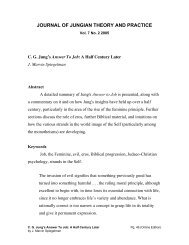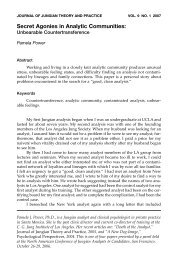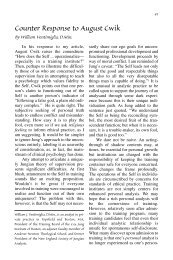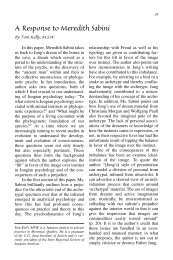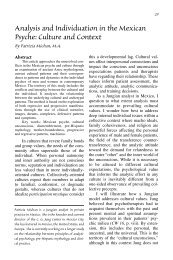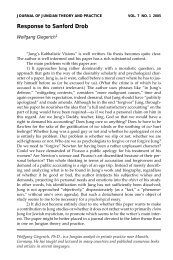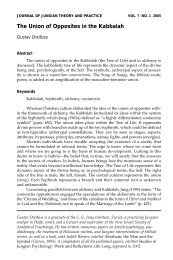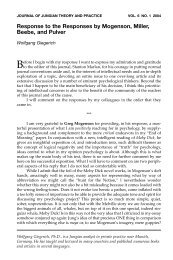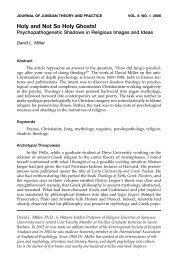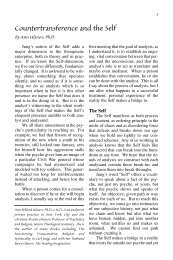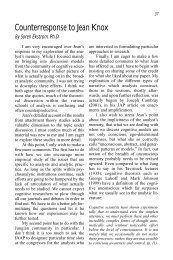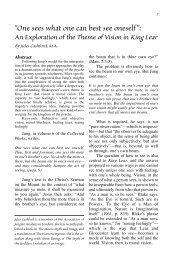Imaginary Friend - CG Jung Institute of New York
Imaginary Friend - CG Jung Institute of New York
Imaginary Friend - CG Jung Institute of New York
You also want an ePaper? Increase the reach of your titles
YUMPU automatically turns print PDFs into web optimized ePapers that Google loves.
10 <strong>Imaginary</strong> <strong>Friend</strong><br />
I never did walk Maggie, but rather I began walking my own dog, now long<br />
dead. I talked to him as I used to when he was alive. Walking my imaginary animal<br />
each night, I was beginning to find my own way, as was Nigel in telling<br />
Sophie’s story, waving his arms half-mad with desire. The dog, up ahead, was<br />
leading me into the future which I couldn’t see in the dark <strong>of</strong> the night, where I<br />
didn’t have to see. I knew there were things I wanted to write about, but I could<br />
wait, the way I wait for other events, the way I am waiting to see what death, in<br />
its time, will bring. I didn’t have to worry about my life ahead <strong>of</strong> time. And my<br />
life wasn’t heavy or serious; rather, I would find myself laughing, spontaneously,<br />
about nothing at all.<br />
As Coleridge (1985, p. 236) said, “Through Imagination, Man discovers the<br />
world as it was meant to be.”<br />
Notes<br />
1). I understand that Lacan speaks <strong>of</strong> the “imaginary” as a developmental stage in infancy.<br />
I am not using the term in that sense but, rather, in the way that Charles Stewart points to<br />
a child’s “imaginary companion” as a stage in the development <strong>of</strong> the symbolic life <strong>of</strong> the<br />
child that accompanies, and is an impetus to, ego development (Stewart, 2001) .<br />
References<br />
Bollas, Christopher. (1987) The shadow <strong>of</strong> the object. <strong>New</strong> <strong>York</strong>: Columbia University Press.<br />
1987.<br />
Conrad, Joseph. (1942). The secret sharer. Garden City: Doubleday, Doran & Company, Inc.<br />
Coleridge, Samuel Taylor. (1985). The collected works <strong>of</strong> Samuel Taylor Coleridge (Vol. 7):<br />
Biographia Literaria. Princeton: Princeton University Press.<br />
Edinger, Edward F. (1995). Melville’s Moby-Dick: An American nekyia. Toronto: Inner City<br />
Books.<br />
Gopnick, Adam. (2002, September 30). Bumping into Mr. Ravioli. The <strong>New</strong> <strong>York</strong>er.<br />
Stewart, Charles. (2001). The symbolic impetus: How creative fantasy motivates development.<br />
London: Free Association.<br />
Taylor, Marjorie. (1999). <strong>Imaginary</strong> companions and the children who create them. Oxford:<br />
Oxford University Press.<br />
Ulanov, A. B. (2001). Finding space. Louisville, KY: Westminster John Knox Press.<br />
Von Franz, M. L. (1970). Puer aeternus (2nd ed.). Boston: Sigo Press.<br />
Whitney, Mark. (1985). Matter <strong>of</strong> heart [Screenplay]. Los Angeles: C. G. <strong>Jung</strong> <strong>Institute</strong> <strong>of</strong> Los<br />
Angeles.<br />
Winnicott, Donald (1991). Playing and reality. <strong>New</strong> <strong>York</strong>: Routledge.



